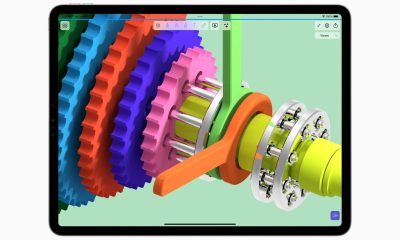Investment
Cathie Wood Gets Crushed By An Investment That Costs 73% Less

|
|
Growth stocks in the S&P 500 are back and tech is hot — playing right into Cathie Wood’s hands. But even the famed investor can’t outperform a cheap index.
Wood’s flagship ARK Innovation ETF (ARKK) is having a good year — up 12.74%, making it the tenth-best diversified ETF this year. But the popular fund is still trailing behind the popular $167 billion-in-assets Invesco QQQ Trust (QQQ), which is up 17.3% this year, says Morningstar Direct.
And it’s not just this year that ARK Innovation is lagging the QQQ, which simply owns the 100 largest nonfinancial stocks trading on the Nasdaq. ARK Innovation also trails the Nasdaq 100 in both the past three and five years as well. And get this: QQQ only charges 0.2% annually, or 73% less than ARK Innovation’s 0.75% fee. That’s not to mention the cheaper version of QQQ, Invesco Nasdaq 100 ETF (QQQM), which costs just 0.15%.
It shows how the top-heavy market — dominated by just a handful of giant stocks — is throwing off even experienced investors.
“We have seen megacap companies found in growth ETF QQQ to be stronger performers in 2023 than more moderately sized companies more commonly found in disruptive technology ETFs,” said Todd Rosenbluth, director of research at VettaFi.
Rise Of Big Cap Tech
Why such a disconnect between ARK Invest and QQQ when growth is in again? Think big-cap tech, says Rosenbluth.
Just six stocks, all of which are also in the Nasdaq 100, are driving 80% of the S&P 500’s gains this year. That includes Apple (AAPL), Microsoft (MSFT), Meta Platforms (META), Nvidia (NVDA), Amazon.com (AMZN) and Alphabet (GOOGL). All are racing higher this year.
These six stocks also collectively account for 50% the value of the Nasdaq 100. But not one of them is in ARK Innovation. That omission is costly now. Take Meta, a social media giant that’s reorganizing itself to lower costs. Shares are up 99% this year, pushing the company’s value to $616 billion. That’s significant as it means Meta is now more valuable that Tesla (TSLA), which is ARK Innovation’s most important holding at 9.7% of the portfolio.
ARK Lagging QQQ Long And Short Term
| ETF | Symbol | YTD return | 3-year annualized return | 5-year annualized return |
|---|---|---|---|---|
| Invesco QQQ Trust | (QQQ) | 17.3% | 14.1% | 14.8% |
| ARK Innovation | (ARKK) | 12.7 | -12.1 | -1.0 |
Source: Morningstar Direct
Lighting Up The Future
Tesla has done well, it’s up 22.7%, but it’s still lagging most of the Nasdaq giant. Apple, Nvidia and Amazon are up 29%, 85.5% and 30.9% respectively. The Nasdaq 100, which also owns Tesla, is up 14.11% and 14.82% in the past three and five years annualized. ARK Innovation is down 12% and 1% during the same periods
So while growth stocks are indeed back, they’re not all back equally. “Growth investing comes in many shapes and sizes and it is important for investors to understand what they own,” Rosenbluth said.
Biggest S&P 500 Gainers All Nasdaq Giants
None of the top performers this year are in ARK Innovation
| Company | Ticker | % of S&P 500’s gain this year | Weight in Nasdaq 100 |
|---|---|---|---|
| Apple | (AAPL) | 25.2% | 12.6% |
| Microsoft | (MSFT) | 20.1% | 12.6% |
| NVIDIA | (NVDA) | 13.1% | 5.1% |
| Meta Platforms | (META) | 12.5% | 3.7% |
| Amazon.com | (AMZN) | 11.3% | 6.3% |
| Alphabet | (GOOGL) | 9.3% | 7.6% |
Sources: IBD, S&P Global Market Intelligence
Follow Matt Krantz on Twitter @mattkrantz





Investment
Want to Outperform 88% of Professional Fund Managers? Buy This 1 Investment and Hold It Forever. – The Motley Fool


You don’t have to be a stock market genius to outperform most pros.
You might not think it’s possible to outperform the average Wall Street professional with just a single investment. Fund managers are highly educated and steeped in market data. They get paid a lot of money to make smart investments.
But the truth is, most of them may not be worth the money. With the right steps, individual investors can outperform the majority of active large-cap mutual fund managers over the long run. You don’t need a doctorate or MBA, and you certainly don’t need to follow the everyday goings-on in the stock market. You just need to buy a single investment and hold it forever.
That’s because 88% of active large-cap fund managers have underperformed the S&P 500 index over the last 15 years thru Dec. 31, 2023, according to S&P Global’s most recent SPIVA (S&P Indices Versus Active) scorecard. So if you buy a simple S&P 500 index fund like the Vanguard S&P 500 ETF (VOO -0.23%), chances are that your investment will outperform the average active mutual fund in the long run.
Image source: Getty Images.
Why is it so hard for fund managers to outperform the S&P 500?
It’s a good bet that the average fund manager is hardworking and well-trained. But there are at least two big factors working against active fund managers.
The first is that institutional investors make up roughly 80% of all trading in the U.S. stock market — far higher than it was years ago when retail investors dominated the market. That means a professional investor is mostly trading shares with another manager who is also very knowledgeable, making it much harder to gain an edge and outperform the benchmark index.
The more basic problem, though, is that fund managers don’t just need to outperform their benchmark index. They need to beat the index by a wide enough margin to justify the fees they charge. And that reduces the odds that any given large-cap fund manager will be able to outperform an S&P 500 index fund by a significant amount.
The SPIVA scorecard found that just 40% of large-cap fund managers outperformed the S&P 500 in 2023 once you factor in fees. So if the odds of outperforming fall to 40-60 for a single year, you can see how the odds of beating the index consistently over the long run could go way down.
What Warren Buffett recommends over any other single investment
Warren Buffett is one of the smartest investors around, and he can’t think of a single better investment than an S&P 500 index fund. He recommends it even above his own company, Berkshire Hathaway.
In his 2016 letter to shareholders, Buffett shared a rough calculation that the search for superior investment advice had cost investors, in aggregate, $100 billion over the previous decade relative to investing in a simple index fund.
Even Berkshire Hathaway holds two small positions in S&P 500 index funds. You’ll find shares of the Vanguard S&P 500 ETF and the SPDR S&P 500 ETF Trust (NYSEMKT: SPY) in Berkshire’s quarterly disclosures. Both are great options for index investors, offering low expense ratios and low tracking errors (a measure of how closely an ETF price follows the underlying index). There are plenty of other solid index funds you could buy, but either of the above is an excellent option as a starting point.
Adam Levy has no position in any of the stocks mentioned. The Motley Fool has positions in and recommends Vanguard S&P 500 ETF. The Motley Fool has a disclosure policy.
Investment
Index Funds or Stocks: Which is the Better Investment? – The Motley Fool Canada


Canadian investors might come across a lot of arguments out there for or against index funds and stocks. When it comes to investing, some might believe clicking once and getting an entire index is the way to go. Others might believe that stocks provide far more growth.
So let’s settle it once and for all. Which is the better investment: index funds or stocks?
Case for Index funds
Index funds can be considered a great investment for a number of reasons. These funds typically track a broad market index, such as the S&P 500. By investing in them you gain exposure to a diverse range of assets within that index, and that helps to spread out your risk.
These funds also tend to have lower expense ratios compared to an actively managed fund. They merely passively track an index rather than a team of analysts constantly changing the fund’s mix of investments. This means lower expenses, and lower fees for investors.
Funds also tend to have more consistent returns compared to individual stocks, which can see significant fluctuations in value. You therefore may enjoy an overall market trending upwards over the long term. This long-term focus can then benefit investors from the power of compounding returns, growing wealth significantly over time.
Case for stocks
That doesn’t mean that stocks can’t be a great investment as well. Stocks have historically provided higher returns compared to other asset classes over the long run. When you invest in stocks, you’re buying ownership of stakes in a company. This ownership then entitles you to a share of the company’s profits through returns or dividends.
Investing in a diverse range of stocks can then help spread out risk. Whereas an index fund is making the choice for you, Canadian investors can choose the stocks they invest in, creating the perfect diversified portfolio for them.
What’s more, stocks are quite liquid. This means you can buy and sell them easily on the stock market, providing you with cash whenever you need it. What’s more, this can be helpful during periods of volatility in the economy, providing a hedge against inflation and the ability to sell to make up income.
In some jurisdictions as well, even if you lose out on stocks you can apply capital losses, reducing overall tax liability in the process. And while it can be challenging, capital gains can also allow you to even beat the market!
So which is best?
I’m sure some people won’t like this answer, but investing in both is definitely the best route to take. If you’re set in your ways, that can mean you’re losing out on the potential returns which you could achieve by investing in both of these investment strategies.
A great option that would provide diversification is to invest in strong Canadian companies, while also investing in diversified, global index funds. For instance, consider the Vanguard FTSE Global All Cap Ex Canada Index ETF Unit (TSX:VXC), which provides investors with a mix of global equities, all with different market caps. This provides you with a diversified range of investments that over time have seen immense growth.
This index does not invest in Canada, so you can then couple that with Canadian investments. Think of the most boring areas of the market, and these can provide the safest investments! For instance, we always need utilities. So investing in a company such as Hydro One (TSX:H) can provide long-term growth. What’s more, it’s a younger stock compared to its utility peers, providing a longer runway for growth. And with a 3.15% dividend yield, you can gain extra passive income as well.
Investment
Former Bay Street executive leads push to require firms to account for inflation in investment reports – The Globe and Mail

Former chief executive officer of RBC Dominion Securities Tony Fell is campaigning to require the Canadian financial industry to account for inflation in how it reports investment returns.Neville Elder/Handout
While the average Canadian is fixated on the price of gasoline and groceries, inflation may be quietly killing their investment returns.
Compounded across many years, even modest inflation can deal a powerful blow to a standard investment portfolio. And investors commonly underappreciate the threat.
But a legend of the Canadian investment banking industry is trying to change that.
Tony Fell, the former chief executive officer of RBC Dominion Securities, is campaigning to require the Canadian financial industry to account for inflation in how it reports investment returns.
“I think they will find this very hard to argue against,” he said in an interview. “It’s a matter of transparency and reporting integrity. But that doesn’t mean it will happen.”
Mr. Fell made his case in a recent letter to the Ontario Securities Commission, arguing that Canadian investors are being misled. He has not yet received a response from the regulator.
Canadians with an investment account receive a statement at least once a year detailing how their investments have performed. For the most part, rates of return are calculated on a nominal basis, meaning they have no inflation component factored in.
A real return, on the other hand, accounts for the hit to purchasing power from rising consumer prices.
These figures, Mr. Fell argues, would give investors a clearer picture of how much they have gained from a given investment.
And since Statistics Canada calculates inflation on a monthly basis, the investment industry would already have access to the data it needs to make the switch to real returns. It would be very little trouble and no extra cost, Mr. Fell said.
Still, he said he expects the investment industry will resist his proposal. “The mutual-fund lobby is so strong, and nobody wants to rock the boat too much.”
He points to the battle to inform Canadians of the investment fees they pay. For 30 years, investor advocates have been pushing for improvements to disclosure.
One major set of regulatory changes, which took effect in 2016, required financial companies to disclose how much clients paid for financial advice.
But the reforms left out one major component of mutual-fund fees. The cost of advice is there, but many investors still don’t see how much they pay in fund-management fees, which amount to billions of dollars paid by Canadians each year.
Total cost reporting, which should finally close the fee-disclosure gap, is set to come into effect in 2026. “It’s outrageous,” Mr. Fell said. “That should have been done years ago.”
So, it’s hard to imagine the industry warmly receiving his proposal, or the regulators enthusiastically pushing for its consideration.
The OSC said it agrees that retail investors need to be attuned to the effects of inflation, which is where investment advisers come in. “Professional advice requires an assessment of risk tolerance and risk appetite in order for an adviser to know their client, including the effect of the cost of living on achieving their financial objectives,” OSC spokesman Andy McNair-West said in an e-mail.
And yet, Mr. Fell said, the need exists for more formal reporting of inflation-adjusted performance.
Inflation often goes overlooked by the industry and investors alike. It can be seen in the celebration of stock indexes at all-time nominal highs, which wouldn’t look so great if inflation were factored in.
The inflationary extremes of the 1970s provide a stark illustration. In 1979, the S&P 500 index posted a total return of 18.5 per cent – a blockbuster year until you consider that inflation was 13.3 per cent.
That took the index’s real return down to a lacklustre 5.2 per cent.
More recently, investors in Canada and the United States piled into savings instruments promising 5-per-cent nominal rates of return. But the rate of inflation in Canada averaged 6.8 per cent in 2022, more than wiping out the return on things such as guaranteed investment certificates, in most cases.
“A lot of people don’t connect those dots,” said Dan Hallett, head of research at HighView Financial Group. “Over 10 years, even 2-per-cent inflation really eats away at purchasing power.”
He worries, however, that reporting after-inflation returns may confuse average investors, many of whom still fail to understand the basic investment fees they’re paying.
All the more reason to get Canadian investors thinking more about inflation, Mr. Fell argues.
“The impact of inflation on investing is sort of forgotten about,” he said. “The only way I can think of turning that around is to highlight it in investors’ statements.”
-



 Investment14 hours ago
Investment14 hours agoUK Mulls New Curbs on Outbound Investment Over Security Risks – BNN Bloomberg
-



 Sports12 hours ago
Sports12 hours agoAuston Matthews denied 70th goal as depleted Leafs lose last regular-season game – Toronto Sun
-



 Tech13 hours ago
Tech13 hours agoSave $700 Off This 4K Projector at Amazon While You Still Can – CNET
-



 Tech12 hours ago
Tech12 hours ago'Kingdom Come: Deliverance II' Revealed In Epic New Trailer And It Looks Incredible – Forbes
-



 Science14 hours ago
Science14 hours agoJeremy Hansen – The Canadian Encyclopedia
-
Business11 hours ago
BC short-term rental rules take effect May 1 – CityNews Vancouver
-



 Investment11 hours ago
Investment11 hours agoBenjamin Bergen: Why would anyone invest in Canada now? – National Post
-
Art11 hours ago
Collection of First Nations art stolen from Gordon Head home – Times Colonist





